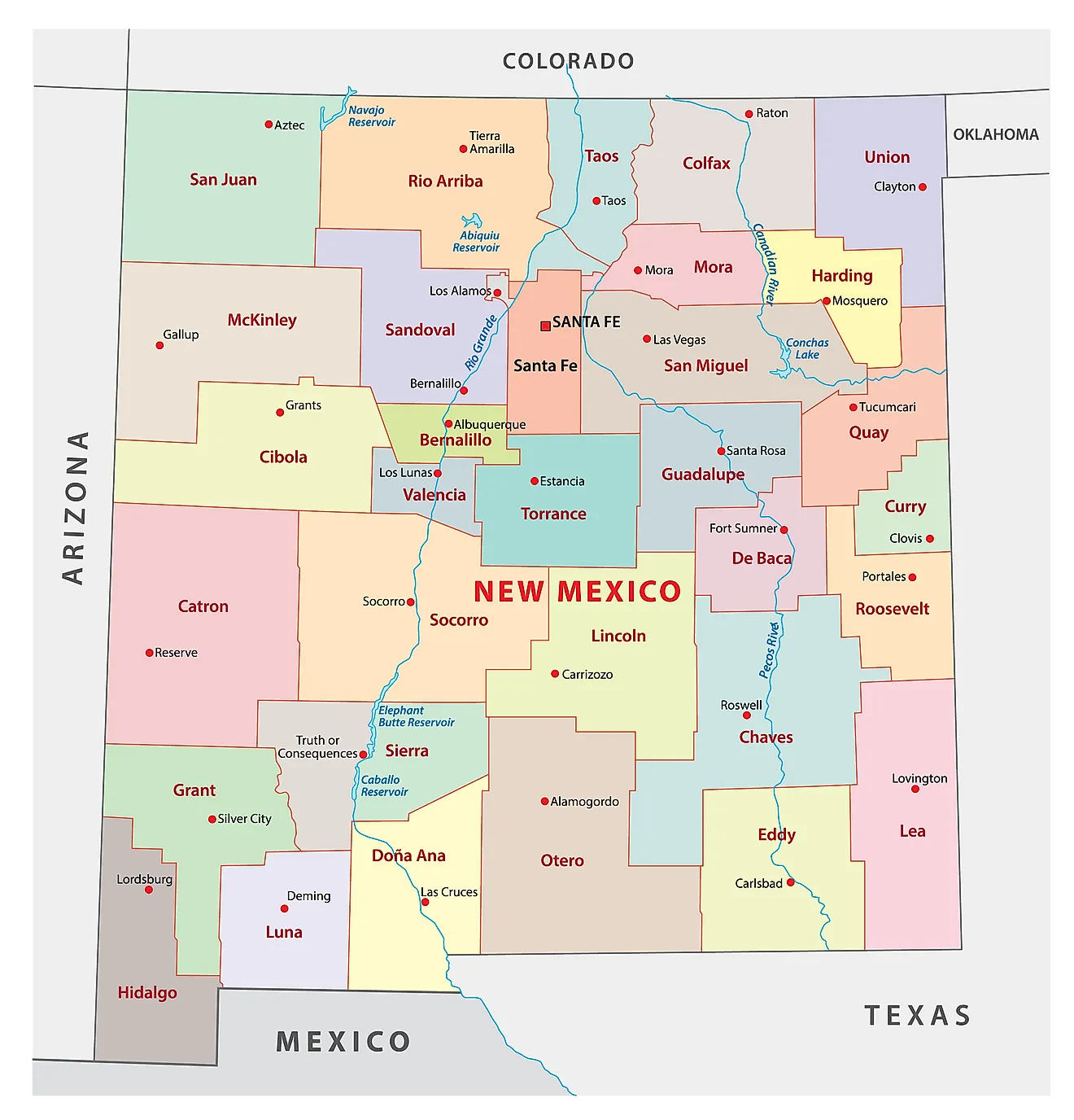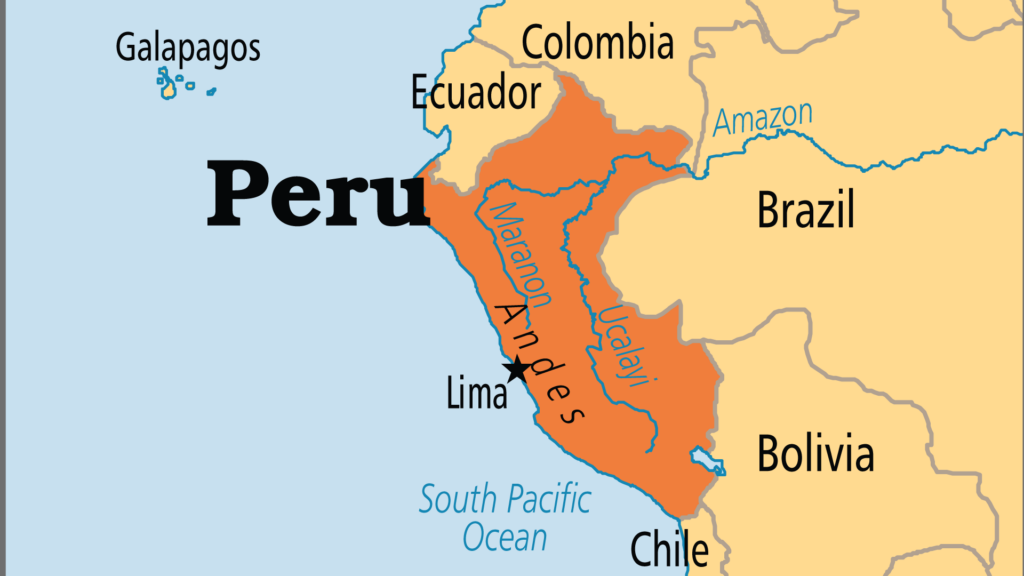Introduction
New Mexico, the Land of Enchantment, is a state in the southwestern United States known for its diverse landscapes, rich cultural heritage, and unique blend of Native American, Hispanic, and Anglo influences. This comprehensive guide provides an in-depth look at New Mexico’s geography, history, culture, economy, and more, supported by detailed maps and essential facts.
Geography
Location and Borders
New Mexico is located in the southwestern region of the United States, bordered by Colorado to the north, Texas and Oklahoma to the east, Arizona to the west, and the Mexican states of Chihuahua and Sonora to the south. It also touches Utah at the Four Corners region. The state spans latitudes 31°20’N to 37°N and longitudes 103°W to 109°3’W.
Topography
New Mexico’s topography is incredibly diverse, ranging from vast deserts to lush forests and high mountain ranges. The state’s landscape can be broadly divided into four regions:
- The Great Plains: Located in the eastern part of the state, this region is characterized by flat plains and rolling hills, gradually rising towards the west.
- The Rocky Mountains: Extending into northern New Mexico, the Rockies include the Sangre de Cristo Mountains, which feature some of the state’s highest peaks, such as Wheeler Peak at 13,167 feet (4,013 meters).
- The Colorado Plateau: Covering the northwestern part of the state, this region is known for its rugged terrain, deep canyons, and high mesas.
- The Basin and Range Province: Dominating the southwestern part of the state, this region consists of desert basins separated by mountain ranges, including the Sacramento and Guadalupe Mountains.
Climate
New Mexico’s climate varies significantly due to its diverse topography:
- Desert Climate: Characterized by hot summers and mild winters, with low annual rainfall. Areas like the Chihuahuan Desert experience this type of climate.
- Mountain Climate: Found in the high elevations of the Rocky Mountains, this climate features cooler temperatures, with significant snowfall during winter.
- Semi-Arid Climate: The most common climate type in New Mexico, marked by moderate rainfall, hot summers, and cold winters. Cities like Albuquerque and Santa Fe experience this climate.
Fun Fact About New Mexico’s Geography
Did you know? New Mexico is home to White Sands National Park, where you can find the largest gypsum dune field in the world. The dunes cover an area of 275 square miles (710 square kilometers) and create a stunning white landscape that looks like snow.
History
Early Inhabitants
New Mexico has a rich history that dates back thousands of years. The region was originally inhabited by various Native American cultures, including the Ancestral Puebloans (Anasazi), who built intricate cliff dwellings and pueblos. The Mogollon and Hohokam cultures also left their mark with impressive archaeological sites.
Spanish Colonization
In the late 16th century, Spanish explorers, led by Juan de Oñate, began to colonize the region. In 1598, Oñate established the first Spanish settlement in New Mexico, San Juan de los Caballeros. Santa Fe, founded in 1610, became the capital of the province of Nuevo México.
Mexican Independence and American Acquisition
Following Mexico’s independence from Spain in 1821, New Mexico became a Mexican territory. However, during the Mexican-American War (1846-1848), the United States captured the region, and it was officially ceded to the U.S. under the Treaty of Guadalupe Hidalgo in 1848.
Statehood and Modern History
New Mexico was admitted as the 47th state of the United States on January 6, 1912. Throughout the 20th century, the state experienced significant growth and development, particularly in the fields of science and technology. The Manhattan Project during World War II, which developed the first atomic bombs, was headquartered in Los Alamos, New Mexico.
Culture
Demographics
New Mexico has a diverse population with a unique cultural blend. According to the U.S. Census Bureau, the state has a population of approximately 2.1 million people. The largest ethnic groups are:
- Hispanic or Latino: 49.3%
- White (Non-Hispanic): 37.4%
- Native American: 10.9%
- African American: 2.6%
- Asian: 1.8%
Languages
New Mexico is one of the few states in the U.S. with a significant bilingual population. Spanish is widely spoken alongside English, and several Native American languages, such as Navajo and various Pueblo languages, are also prevalent.
Religion
The predominant religion in New Mexico is Christianity, with a strong Roman Catholic presence due to the state’s Spanish colonial heritage. Other religious groups include Protestant denominations, Native American spiritual practices, and smaller communities of other faiths.
Festivals and Traditions
New Mexico is known for its vibrant festivals and cultural events, which reflect its diverse heritage:
Santa Fe Indian Market
Held annually in August, this market is one of the largest and most prestigious Native American art shows in the world.
Albuquerque International Balloon Fiesta
Every October, hundreds of hot air balloons take to the skies in one of the most photographed events on the planet.
Fiestas de Santa Fe
Celebrating the founding of Santa Fe, this event features parades, music, traditional dances, and the burning of Zozobra, a giant marionette symbolizing gloom.
Cuisine
New Mexican cuisine is a distinctive blend of Native American, Spanish, and Mexican influences. Key ingredients include chile peppers, corn, and beans. Some popular dishes are:
- Green Chile Stew: A hearty stew made with green chile, pork, potatoes, and other vegetables.
- Enchiladas: Corn tortillas filled with meat, cheese, or beans, topped with red or green chile sauce.
- Sopapillas: Fried pastries often served with honey, enjoyed as a dessert or a side dish.
Economy
Overview
New Mexico’s economy is diverse, with key sectors including oil and gas, tourism, agriculture, aerospace, and federal government spending, particularly in defense and research.
Key Industries
- Oil and Gas: New Mexico is one of the leading oil and natural gas producers in the United States. The Permian Basin, located in the southeastern part of the state, is a major source of petroleum.
- Tourism: The state’s rich cultural heritage, national parks, and scenic landscapes attract millions of visitors each year.
- Agriculture: Important agricultural products include cattle, dairy, pecans, and chile peppers.
- Aerospace and Defense: Home to several military bases and research facilities, including Los Alamos National Laboratory and White Sands Missile Range.
Trade
New Mexico’s trade is influenced by its geographic location and natural resources. The state exports a variety of goods, including oil and gas, agricultural products, and manufactured goods. Major trading partners include Mexico, Canada, and various countries in Asia and Europe.
Maps of New Mexico
Political Map
A political map of New Mexico shows the state’s 33 counties, major cities, and towns. Key cities such as Albuquerque (the largest city), Santa Fe (the capital), Las Cruces, and Rio Rancho are highlighted.
Physical Map
A physical map of New Mexico highlights its diverse landscapes, including:
- Mountain Ranges: Sangre de Cristo Mountains, Sacramento Mountains, and the Sandia Mountains.
- Deserts: Chihuahuan Desert and parts of the Painted Desert.
- Rivers: Rio Grande, Pecos River, and Canadian River.
Road Map
A road map of New Mexico shows the state’s major highways and roads, including:
- Interstate Highways: I-10, I-25, and I-40.
- U.S. Highways: US-54, US-60, US-64, and others.
Tourist Map
A tourist map of New Mexico highlights major attractions and landmarks, such as:
- Carlsbad Caverns National Park
- White Sands National Park
- Bandelier National Monument
- Taos Pueblo
- Chaco Culture National Historical Park
Fun Fact About New Mexico Maps
Did you know? New Mexico’s state question is “Red or Green?” referring to the choice of red or green chile sauce that is commonly asked in restaurants throughout the state.
Frequently Asked Questions (FAQs) About New Mexico
What is the capital of New Mexico?
The capital of New Mexico is Santa Fe, known for its historic architecture, vibrant arts scene, and rich cultural heritage.
What is New Mexico’s largest city?
Albuquerque is New Mexico’s largest city, offering a mix of modern urban amenities and historic attractions, including the annual Albuquerque International Balloon Fiesta.
What are the major industries in New Mexico?
Major industries in New Mexico include oil and gas, tourism, agriculture, aerospace, and federal government spending, particularly in defense and research.
What is unique about New Mexico’s cuisine?
New Mexican cuisine is distinctive for its use of chile peppers, both red and green, which are integral to many traditional dishes such as enchiladas, green chile stew, and sopapillas.
What are some popular tourist attractions in New Mexico?
Popular tourist attractions in New Mexico include Carlsbad Caverns National Park, White Sands National Park, Taos Pueblo, Bandelier National Monument, and the historic town of Santa Fe.
How does New Mexico’s geography influence its climate?
New Mexico’s diverse geography, which includes deserts, mountains, and plains, results in a range of climates from hot desert conditions to cooler mountain environments.
What cultural events are celebrated in New Mexico?
New Mexico hosts a variety of cultural events, including the Santa Fe Indian Market, Albuquerque International Balloon Fiesta, and Fiestas de Santa Fe.
How did New Mexico become a part of the United States?
New Mexico became a part of the United States following the Mexican-American War, officially ceded by Mexico under the Treaty of Guadalupe Hidalgo in 1848, and later admitted as the 47th state in 1912.
What languages are commonly spoken in New Mexico?
English and Spanish are widely spoken in New Mexico, along with several Native American languages such as Navajo and Pueblo languages.
What are some key natural features of New Mexico?
Key natural features of New Mexico include the Rio Grande, the Sangre de Cristo Mountains, White Sands National Park, and the Chihuahuan Desert.
Conclusion
New Mexico is a state of contrasts and diversity, offering a rich tapestry of landscapes, cultures, and histories. From its high desert plains and towering mountains to its vibrant cities and ancient pueblos, New Mexico is a place of endless discovery and enchantment. Whether you’re interested in exploring its natural beauty, delving into its storied past, or experiencing its unique cultural traditions, New Mexico has something to offer everyone. This guide provides a comprehensive overview, but the true magic of New Mexico can only be fully appreciated through personal experience and exploration.
- 7 Reasons Why Rome Fell - July 26, 2024
- 7 Interesting Facts About Ancient Greece - July 26, 2024
- East African Countries - July 19, 2024




